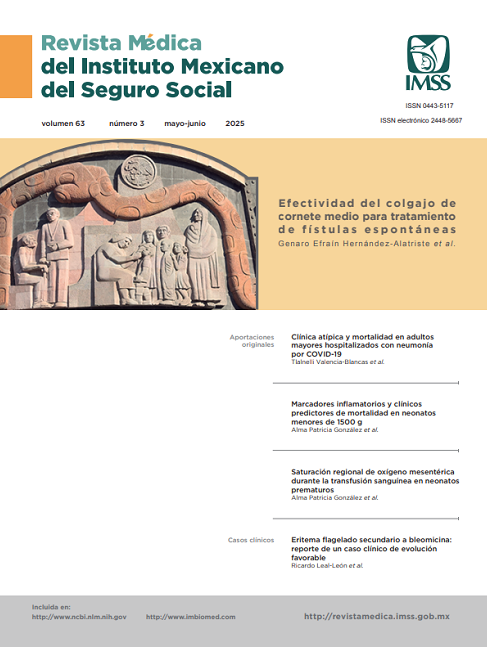Flagellate erythema secondary to bleomycin: case report with favorable outcome
Main Article Content
Keywords
Erythema, Bleomycin, Hyperpigmentation
Abstract
Background: Flagellate erythema (FE) is a multifactorial dermatosis, frecuently related to the the use of certain drugs. It can occur in up to 20% of patients treated with bleomycin. Drug accumulation in the skin can be due to the lack of the enzyme bleomycin hydrolase. It presents as a widespread dermatosis, predominantly affecting the trunk and upper extremities, characterized by erythematous-hyperpigmented macules of variable size, with a linear arrangement and a "whip-like" appearance, associated with intense pruritus. Management focuses on relieving pruritus with antihistamines and topical steroids, although discontinuation of bleomycin is essential for complete resolution.
Case report: A 19-year-old woman with a history of stage IIIB left ovarian dysgerminoma was undergoing combined chemotherapy (bleomycin, etoposide, and cisplatin). After 3 months of treatment, she developed a widespread dermatosis on the neck and posterior thoracic region, consisting of dark brown hyperpigmented spots with a linear configuration and variable sizes, associated with pruritus, without other symptoms. FE due to bleomycin was diagnosed. High-potency topical corticosteroids were prescribed. After discontinuing bleomycin, there was a progressive disappearance of the dermatosis until complete resolution.
Conclusion: The bleomycin-induced FE must be identified early for appropriate management that allows the continuation of antineoplastic treatment. Discontinuation of the drug should be considered when the patient's quality of life is compromised and balanced with oncological control, which optimizes antineoplastic therapy.
References
Mavridou A. Flagellate dermatitis in a patient with testicular germ cell neoplasia on bleomycin. Dermatology Reports. 2023;15(1):e9761. doi: 10.4081/dr.2023.9761
Constantinou A, Koutouzis M, Koutouzis T, et al. A closer look at chemotherapy‐induced flagellate dermatitis. Skin Health and Disease. 2022;2(1):e92. doi: 10.1002/ski2.92
Sunigdha S, Kumar A, Gupta S, et al. Bleomycin-Induced Flagellate Dermatitis in Indian Patients with Germ Cell Tumors. Indian Journal of Medical and Paediatric Oncology. 2022;43(1):e1-e5. doi: 10.1055/s-0042-1749394
Lee Y, Kim J, Kim Y, et al. Bleomycin-induced flagellate erythema: A case report and review of the literature. Oncology Letters. 2014;8(6):2615-8. doi: 10.3892/ol.2014.2179
Verma S, Gupta S, Kumar A, et al. Bleomycin-Induced Flagellate Dermatitis: Revisited. Cureus. 2022;14(8):e29221. doi: 10.7759/cureus.29221
Cullingham A, Kost J. A case of bleomycin-induced flagellate dermatitis: A case report. Sage Open Medical Case Reports. 2021;9:2050313X211039476. doi: 10.1177/2050313x211039476
Indrastuti R, Kurniawan A, Sari R, et al. Flagellate dermatitis in bleomycin chemotherapy: a causality? BMJ Case Reports. 2022;15(1):e249704. doi: 10.1136/bcr-2022-249704
Todkill D, Taibjee S, Borg A, et al. Flagellate erythema due to bleomycin. Br J Haematol. 2008;142(6):857. doi: 10.1111/j.1365-2141.2008.07238.x
Tonin F, Vukadinovic M, Jovanovic M, et al. Bleomycin-induced Flagellate Dermatitis: a Case Report. Serbian Journal of Dermatology and Venerology. 2020;12(1):34-7. doi: 10.2478/sjdv-2020-0003
Boppana SM, Vegesana BP. Bleomycin induced flagellate dermatitis: A clinical image. J Clin Images Med Case Rep. 2023;4(12):2746.
Droppelmann M, González C, Araya J, et al. Eritema Flagelado por ingesta de hongos Shiitake: reporte de caso. Revista Chilena de Dermatología. 2018;33(3):162-5. doi: 10.31879/rcderm.v33i3.162
Jannic A, Boulanger N, Dufour C, et al. Flagellate erythema in systemic sclerosis: A case report. JAAD Case Reports. 2018;4(2):144-6. doi: 10.1016/j.jdcr.2017.09.013
Ching A, Wong J, Wong C, et al. Histological Features of Flagellate Erythema. American Journal of Dermatopathology. 2019;41(4):273-8. doi: 10.1097/dad.0000000000001271
Garg A. Bleomycin-induced Flagellate Dermatitis. Indian Journal of Paediatric Dermatology. 2023;24(1):1-3. doi: 10.4103/ijpd.ijpd_97_22
Pereira R, Morbeck A. Flagellate Erythema Secondary to Bleomycin for Non-Seminomatous Testis Tumor. Brazilian Journal of Case Reports. 2021;1(3):86-9. doi: 10.52600/2763-583x.bjcr.2021.1.3.86-89
Sauteur P, Theiler M. Mycoplasma pneumoniae–associated flagellate erythema. JAAD Case Reports. 2020;6(5):467-9. doi: 10.1016/j.jdcr.2020.09.029
Yılmaz U, Zulfaliyeva G, Güzelli AN, et al. Does discontinuing bleomycin due to toxicity increase the risk of lymphoma progression? Real-life data from a homogeneous population of advanced stage Hodgkin lymphoma. J Chemother. 2024;36(5):403-10. doi: 10.1080/1120009X.2023.2281089
Vegesana K. Bleomycin induced flagellate dermatitis: A clinical image. Journal of Clinical Images and Medical Case Reports. 2023;1(1):1-3. doi: 10.52768/2766-7820/2746
Martinez-Cabrera I, Lopez-Estebaranz JL. Bleomycin-induced flagellate erythema in patients undergoing chemotherapy: Clinical review. Clin Exp Dermatol. 2023;48(2):234-9. doi: 10.1111/ced.15394
Simons MJ, Robinson J, Harris C, et al. Long-term outcomes of chemotherapy-induced dermatologic reactions: A cohort study. J Am Acad Dermatol. 2022;86(5):1075-82. doi: 10.1016/j.jaad.2021.11.022
Thompson RD, Kahn LG. Management strategies for chemotherapy-induced flagellate dermatitis. Int J Dermatol. 2023;62(7):903-10. doi: 10.1111/ijd.16311
Aguilar MT, Vasquez J, Mendoza A. Case report: Severe flagellate erythema after bleomycin treatment in a young adult. BMJ Case Reports. 2021;14(3):e240512. doi: 10.1136/bcr-2020-240512
Yu H, Zhao J, Liu C. Comparative study of flagellate erythema: Drug-induced versus idiopathic causes. Dermatol Ther. 2023;36(1):e15799. doi: 10.1111/dth.15799


